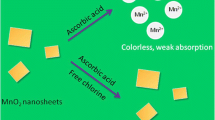Abstract
An organic/inorganic hybrid compound consisting of methylene blue, a cationic surfactant and a reductant intercalated into saponite was found to serve as an oxygen indicator that changes color in the presence of oxygen. A mixture of a blue colored dye, methylene blue, a reductant in the form of ascorbic acid or reducing sugar, and cetyltrimethylammonium ion intercalated into synthetic saponite became colorless in an atmosphere having an oxygen concentration of less than 0. 1 vol%, and then returned to its blue color as a result of subsequent exposure to air. An oxygen indicator, in the form of a thin film coated on paper prepared by adding a pigment, phloxine B, to the above organic/inorganic hybrid compound, exhibited a pink color at oxygen concentrations of less than 0.1 vol%, and a blue color at oxygen concentrations of higher than 0.5 vol%. In addition, this oxygen indicator exhibited superior photo-fading resistance and storage stability compared with indicators using only methylene blue as the functional dye.
Similar content being viewed by others
References
A. L. Brody, E. R. Strupinsky, and L. R. Kline, “Active Packaging for Food Applications”, 2001, Technomic, Lancaster, 12.
Y. Amao, K. Asai, T. Miyashita, and I. Okura, Polymer J., 1999, 31(12), 1267.
Y. Amao, K. Asai, and I. Okura, Porphyrins, 1999, 8(2), 77.
C. Malins, S. Fanni, H. G. Glever, J. G. Vos, and B. D. MacCraith, Anal. Commun., 1999, 36, 3.
M. T. Murtagh, M. R. Shahriari, and M. Krihak, Chem. Mater., 1998, 10, 3862.
M. V. Riemsdijk, Nederland. Tijdschr. Geneeskunde, 1922, 66, I, 1423.
W. M. Clark and B. Cohen, Abstracts Bact., 1925, 9, 11.
Y. Yoshikawa, Y. Fujii, T. Nawata, and M. Goto, a) Japan Patent, 1981, 1052402; b) Japan Patent, 1984, 1218096; c) U. S. Patent, 1979, 4169811.
M. Nakamoto and K. Omoto, Japan Patent, 1988, 1449258.
Y. Yoshikawa, T. Nawata, M. Goto, and Y. Kondo, U. S. Patent, 1982, 4349509.
J. K. Thomas, Acc. Chem. Res., 1988, 21, 275.
J. K. Thomas, Chem. Rev., 1993, 93, 301.
M. Ogawa and K. Kuroda, Chem. Rev., 1995, 95, 399.
K. Takagi and T. Shichi, in “Solid State and Surface Photochemistry ”, ed. V. Ramamurthy and K. S. Schanze, 2000, Vol. 5, Marcel Dekker, New York, 1977.
K. Takagi and T. Shichi, J. Photochem. Photobiol. C: Photochem. Rev., 2000, 1, 112.
C. Kato, a) Koubunshi, 1979, 28, 575; b) Japan Patent, 1975, 0795548; c) U. S. Patent, 1976, 3950180.
T. Itoh, K. Yano, Y. Inada, and Y. Fukushima, J. Mater. Chem., 2002, 12, 3275.
T. Itoh, K. Yano, Y. Inada, and Y. Fukushima, J. Am. Chem. Soc., 2002, 124, 13437.
H. Rozen and L. Margulies, J. Agric. Food Chem., 1991, 39, 1320.
M. A. Caine, R. W. McCabe, L. Wang, R. G. Brown, and J. D. Hepworth, Dyes Pigm., 2002, 52, 55.
K. Banerjee and P. Dureja, Pestic. Sci., 1995, 43, 333.
L. Margulies, H. Rozen, T. Stern, G. Rytwo, B. Rubin, L. O. Ruzo, S. Nir, and E. Cohen, Arch. Insect Biochem. Physiol., 1993, 22, 467.
L. Margulies, H. Rozen, and E. Cohen, Clays Clay Miner., 1988, 36, 159.
L. A. Lucia, T. Yui, R. Sasai, S. Takagi, K. Takagi, H. Yoshida, D. G. Whitten, and H. Inoue, J. Phys. Chem. B, 2003, 107, 3789.
T. Yui, S. R. Uppili, T. Shimada, D. A. Tryk, H. Yoshida, and H. Inoue, Langmuir, 2002, 18, 4232.
S. Xu and S. A. Boyd, Langmuir, 1995, 11, 2508.
Y. Sakai, N. Kato, M. Arai, F. Takahashi, and Y. Nishida, Bull. Chem. Soc. Jpn., 2002, 75, 2403.
S. Takagi, T. Shimada, T. Yui, and H. Inoue, Chem. Lett., 2001, 128.
S. Takagi, T. Shimada, M. Eguchi, T. Yui, H. Yoshida, D. A. Tryk, and H. Inoue, Langmuir, 2002, 18, 2265.
Y. Yamaguchi, Y. Yui, S. Takagi, T. Shimada, and H. Inoue, Chem. Lett., 2001, 644.
Author information
Authors and Affiliations
Corresponding author
Rights and permissions
About this article
Cite this article
Sumitani, M., Takagi, S., Tanamura, Y. et al. Oxygen Indicator Composed of an Organic/Inorganic Hybrid Compound of Methylene Blue, Reductant, Surfactant and Saponite. ANAL. SCI. 20, 1153–1157 (2004). https://doi.org/10.2116/analsci.20.1153
Received:
Accepted:
Published:
Issue Date:
DOI: https://doi.org/10.2116/analsci.20.1153




